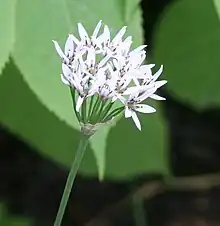| Allium ramosum | |
|---|---|
 | |
| Scientific classification | |
| Kingdom: | Plantae |
| Clade: | Tracheophytes |
| Clade: | Angiosperms |
| Clade: | Monocots |
| Order: | Asparagales |
| Family: | Amaryllidaceae |
| Subfamily: | Allioideae |
| Genus: | Allium |
| Subgenus: | A. subg. Butomissa |
| Species: | A. ramosum |
| Binomial name | |
| Allium ramosum L. 1753 not Georgi 1779 nor Jacq. 1781 | |
| Synonyms[2][3] | |
|
Synonymy
| |
Allium ramosum, called fragrant-flowered garlic[4] or Chinese chives[5][6] is a northern Asian species of wild onion native to Kazakhstan, Mongolia, Siberia, the Russian Far East, and northern China (Gansu, Hebei, Heilongjiang, Jilin, Liaoning, Inner Mongolia, Ningxia, Qinghai, Shaanxi, Shandong, Shanxi, Xinjiang).[3][7][8][9][10] The species is also naturalized in a few places in eastern Europe.[3][11] In its native range, it grows at elevations of 500–2100 m.[12]
Allium ramosum has clusters of narrow bulbs. Scapes are up to 60 cm tall. Leaves are linear, keeled, shorter than the scape. Umbels have many flowers crowded together. Tepals are white or pale red with a red midvein.[12][13][14]
Uses
Allium ramosum is traditionally eaten in northern China and Mongolia. It is gathered between May and July, then preserved with salt for the winter.[15] It is then used to season boiled mutton, or stuffed into dumplings.[15] It is also used to treat stomach ailments.[15] The flowers are gathered in late July and August, and salted.[15]
References
- ↑ Rhodes, L.; Maxted, N. (2016). "Allium ramosum". IUCN Red List of Threatened Species. 2016: e.T172189A47600679. doi:10.2305/IUCN.UK.2016-3.RLTS.T172189A47600679.en. Retrieved 18 November 2021.
- ↑ The Plant List
- 1 2 3 Kew World Checklist of Selected Plant Families
- ↑ Sunny Gardens, Allium ramosum, Fragrant-Flowered Garlic
- ↑ All Things Plant, Photo of the bloom of Chinese Chives (Allium ramosum) posted by zuzu
- ↑ "Allium ramosum". Plants for a Future.
- ↑ Malyschev L.I. & Peschkova , G.A. (eds.) (2001). Flora of Siberia 4: 1-238. Scientific Publishers, Inc., Enfield, Plymouth.
- ↑ Sheremetova, S.A., Ebel, A.L. & Buko, T.E. (2011). Supplement to the flora of Kemerovo region since 2001 till 2010. Turczaninowia 14(1): 65-74.
- ↑ Choi, H.J. & Oh, B.U. (2011). A partial revision of Allium (Amaryllidaceae) in Korea and north-eastern China. Botanical Journal of the Linnean Society 167: 153-211.
- ↑ Veklich,T.N. (2012). Novelties of vascular flora of the Zeyskiy reserve (Amur region). Turczaninowia 15(2): 51-54.
- ↑ Seregin, A. & Korniak, T. (2013). Allium ramosum L. (Amaryllidaceae), a neglected alien in the European flora and its oldest record from Poland. Phytotaxa 134: 61-64.
- 1 2 Flora of China v 24 p 180 野韭 ye jiu Allium ramosum
- ↑ Y.P.Hsu. 1987. Acta Botanica Boreali-Occidentalia Sinica. Yangling 7(4): 259.
- ↑ Linnaeus, Carl von. 1753. Species Plantarum 1: 296.
- 1 2 3 4 Pieroni, Andrea (2005). Prance, Ghillean; Nesbitt, Mark (eds.). The Cultural History of Plants. Routledge. p. 35. ISBN 0415927463.
